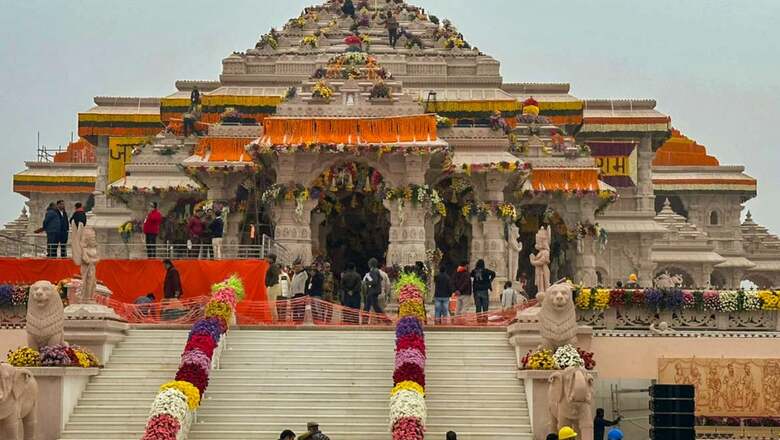
views
Hindu spiritual assertiveness is a strange and beautiful thing. It does not convert one by the sword. It does not scream from loudspeakers, “Raliv, chaliv, ya galiv (convert, leave, or die).” It does not fire on defenceless devotees or set them on fire in a train. It does not let water from its feet smear someone else’s objects of worship. It simply overwhelms the world with songs, dance, chants, mantras, smiles, colours, and an explosion of celebration.
The Pran Pratishtha ceremony of Shri Ram, in his birthplace Ayodhya, 496 years after a commander of the marauding Islamic invader Babur ordered the destruction of the temple and building of the Babri Masjid on its remains, brings history a full circle. It has never been so awake or unapologetic about its dharma perhaps in the last thousand years of relentless invasions and colonialism.
Many argue that a Hindu rashtra is already in motion in Bharat that is India. Bharat is Hindu in spirit. And that is not a bad thing. People of other religions can still coexist with all basic rights, cultural diversity, and dignity.
There are more than 125 Christian-majority nations, of which about 20 are declared Christian states like the UK or Denmark. Many more, while declaring secularism as state policy, run by Christian ideals. The American President, for instance, takes the oath or affirmation of office by raising his right hand, with the left hand on the Bible, saying the words: “So help me God.”
More than 50 Muslim-majority nations run on Islamic ideals, often Sharia laws. Two Muslim rashtras were, in fact, torn out of India.
Jews have a home in Israel. Buddhism is the state religion of Myanmar, Cambodia, Bhutan and Sri Lanka.
There is no exceptionalism in more than a billion Hindus asking for a Hindu rashtra in the land where the ancient faith was born and still breathes. Trying to shame Hindus or Indic religions for wanting a Hindu rashtra is hypocrisy.
But to attain the ideals of a Hindu rashtra and not have it merely as tokenism, a few things need to change. Most of these changes need to be constitutional in order to back up the cultural revival and consolidation which we are witnessing.
First, one needs to do away with the concept of ‘minority’, especially in the context of religious minorities. The Constitution of India uses the word ‘minorities’ in its plural form in Articles 29 to 30 and 350(a) to 350(b). But does not define it anywhere. Muslims and Christians as religious minorities is just an interpretation. How can 200 million people, with an Umma of 2 billion, claim minority benefits?
The Parliament needs to scrap the term ‘minority’. After assessing numbers and vulnerabilities, it should clearly define special categories which need the State’s help. It also needs to take off the creamy layer in cases of affirmative action and reservation so that only the needy avail of these.
Second, declare Bharat as the natural home for people of Indic religions — Hindus, Buddhists, Sikhs, Jains and the indigenous people. Just like Israel is the natural home for Jews across the world. Any Hindu suffering persecution anywhere in the world should get shelter in India without having to wait endlessly.
Third, India needs to legally end mass conversions from the Indic faiths. Only individual cases, after proper scrutiny, could be allowed. Reconversions or ghar wapsi, however, should be allowed because of the wanton demographic shifts and dispossession which have historically taken place.
Amend Article 25 which deals with religious freedom. In its current form, it skews the playing field in favour of Abrahamic religions which aggressively convert and disadvantages Indic faiths which so far did not have a well-developed conversion or reconversion mechanism.
Fourth, scrap the Waqf Act, 1995. It is a singularly sinister piece of legislation which allows the Waqf Board to arbitrarily grab land from individuals and organisations without much of a redressal. It has the potential to create Gazas within India in the future.
Fifth, the Places of Worship Act, 1991, must go. It prohibits Hindus from claiming their shrines which have been robbed before 1947, forcing instead a political status quo. It is a badly thought-out law which is unlikely to stand scrutiny.
Sixth, temples need to be freed from state control and minority educational institutions must be brought under the Right to Education. Both are highly discriminatory against Hindus. One facilitates the robbery of temple funds for non-community activities and lining the pockets of corrupt politicians and bureaucrats. The other cripples non-minority educational institutions with quotas for the economically weak but spares minority ones from accountability.
Seventh and last, bring a fool-proof nationwide NRC and a strict, universally executed population law. The NRC should be able to bust documents procured through bribing, ascertain nationality through generational verification, and promptly disenfranchise and deport illegals. The population law should punish the first instance of breach by taking away government benefits and disenfranchising in the next instance.
Not only has Bharat been living under a colonial cloud, many of its laws are weaponised against the civilisation. That must change. That is the logical next step of a Ram Rajya.
Abhijit Majumder is a senior journalist. Views expressed in the above piece are personal and solely that of the author. They do not necessarily reflect News18’s views.













Comments
0 comment